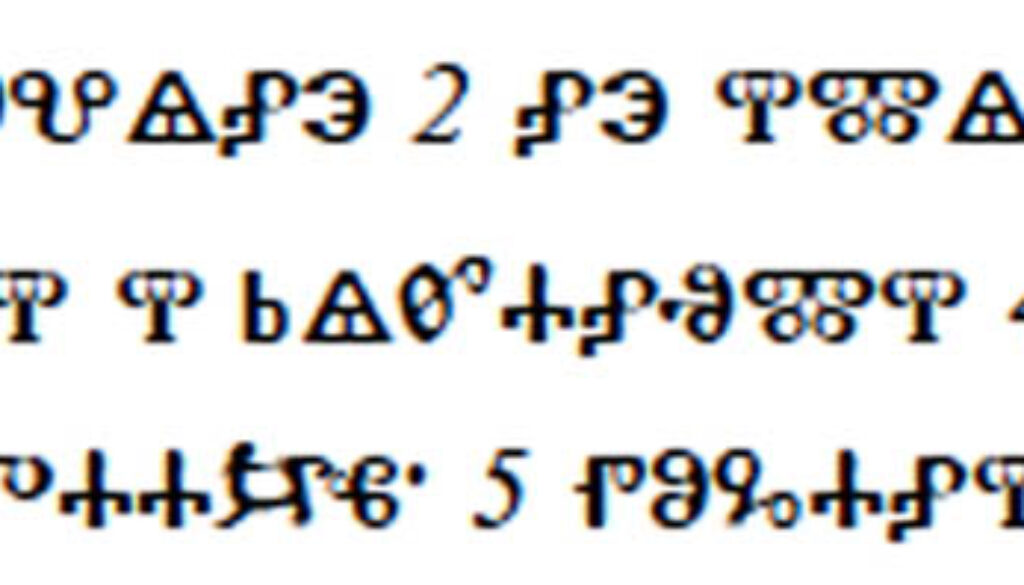Hunting the Dinosaur: Glagolitic

Let’s face it, even the name sounds like a genus of dinosaur: Glagolyticus paleographus. In fact, showing my usual oceanic ignorance, I didn’t even include the Glagolitic script in the original Endangered Alphabets exhibition because I thought it was extinct.
All this changed because of an intervention from a most unlikely source: Will Shortz, the crossword puzzle editor of the New York Times and all-round word and puzzle maven. He and I were once colleagues when we both worked for NPR’s Sunday Weekend Edition, but that didn’t turn out to be the connection that led to Glagolitic.
Toward the end of May he emailed me out of the blue:
“Will Shortz here, the crossword editor of the New York Times … to ask if you’d be willing to speak at an annual event I direct on words.
“The event is called the Wonderful World of Words. It takes place each November at Mohonk Mountain House in New Paltz, NY (south of Albany, about 4 hours from Burlington). This year’s 31st annual event will take place November 16-18.
Each year there are three guest speakers on language-related topics, along with word games, a puzzle treasure hunt, and other activities. Past speakers have included Stephen Sondheim, Dick Cavett, Mary Higgins Clark, Bob Mankoff (the cartoon editor of The New Yorker), Ben Cheever (the writer), Ira Glass (of public radio’s “This American Life”), Tim Long (writer/producer for “The Simpsons”), lexicographers, poets, and other assorted word people.
“I read about you in a forthcoming book by Kee Malesky called Learn Something New Every Day. Then I followed up online. I think the subject of vanishing (and lost) alphabets would be fascinating for this audience. Would you be interested and available to speak?
“FYI, Mohonk is a 140-year-old Victorian castle built on a mountaintop lake — a National Historic Landmark — surrounded by miles of wilderness. Every guest room has a fireplace. The meals are taken in a large communal dining room, with first-class food. (The Words speakers usually eat together.) There is a small library from which you can borrow any book for the weekend. There’s also a brand-new spa and pool, a movie room, tennis courts, a golf course, and 85 miles of hiking trails.”
Needless to say, his words had barely cooled on my monitor before I had replied saying “Yes, yes, hell yes.” In a conversational follow-up email, he happened to mention a slightly different subject.

“A few years ago I was touring an old monastery in Eastern Europe (Hungary? Ukraine? Belarus? I can’t remember), which had a display of bibles from 800-1,000 years ago written in an alphabet I’d never seen before. I found this oddly fascinating. Where did this alphabet come from, and why did it die out?”
Knowing (as I say) virtually nothing about anything in the world of paleography but having a velcroic memory for the random lint of information, I suggested it might be Glagolitic. Being a word dude, Will of course shot off and looked it up, and sure enough, yes, the mystery script had been Glagolitic. (From now on I shall refer to ti by the abbreviation “Glag,” which may sound lazy and irreverent but somehow reminds me of one of my few other Balkan words: Vlad, as in “the Impaler.”)
I there and then decided that when I go down to Will’s Wonderful World of Words, I’m going to present him with a carving in Glag.
I knew exactly what the text should say. It should be a text I’ve carved twice before (in Classical Mongolian), a text that has all kinds of interesting meanings but is especially suitable for someone like Will Shortz. It would would be the opening of the Gospel according to John: “In the beginning was the Word….”
But how would I find that text in Glag? I turned out, as I started burrowing into the labyrinths of the Internet, that the actual language used by the Greek Orthodox church as it made its way north and northeast through the Balkans to Russia was called Old Church Slavonic (OCS).
At least two different scripts were devised to write the gospels in OCS. One, which survived the next 800 years or so, albeit in a variety of forms was Cyrillic, named after St. Cyril. (Who kew? I always thought “Cyrillic” was Russian for “And if you think our script looks warlike, wait until you see our missiles.”) The other was Glag, which according to conventional wisdom had hung around in church services for several centuries, thus proving the incredibly deep relationship between religion and writing, but had finally petered out off the Dalmatian coast on the island of Krk.
But maybe there were still a couple of scholars who could read and write Glag, or maybe (as was the case with Classical Mongolian) someone had translated the Bible into OCS using the Glag script, and I could simply work out where the Gospel of John started and copy the first few words.
Mind you, I use the word “words” rather flexibly, as Glag is an incredibly complicated script. It exists in two versions, a round one and an angular one, and even the round version each letter seems to have been not written but constructed out of tubular Legos. There’s a theory, in fact, that it was created to look deliberately ornate (if that’s the word) to impress the Slavs that the Word of God was intrinsically superior to, say, the Word of Vlad.
Still, all this dubious knowledge wasn’t getting me any closer to having a carvable text in Glag, so I fired up my LinkedIn connections, joined a listserv of Early Slavists and send out a plea for help. That’s when things started getting even more interesting.
First of all, it became immediately clear that Glag is no more dead than Latin, and perhaps even less so. Several scholars professed great interest in Glag; some sent me links to texts in Glag, reproductions of church wall inscriptions in Glag, and documents in Glag, most of them centuries old. Others sent me the Gospel of John in Old Church Slavonic’s version of cyrillic, which looked distinctly unSoviet and unwarlike.
Moreover, the search quickly zoomed in on the island of Krk (where I actually spent a night in 1973, trapped by an unreliable ferry, though I wasn’t looking for archaic scripts in those days).One sent me to a website which had photos of Glag still in use on Krk, one photo showing a small motorboat with its name in Glag on its side, another showing a restaurant menu in Glag!
But did these images represent Glag in use as a living script? Tomislav Bali, a Croatian historian, wrote: ” Unfortunately, I can not confirm that the Glagolitic is still in use on Croatian islands. In the 20th century, the only ones who wrote and read glagolitic were mostly priests. With their deaths (eg. don Marko Cvitanović on Pašman died 1977, don Vinko Rasol on Silba in 1965), practical usage of Glagolitic disappeared. I am not familiar with the fact that anyone use the Glagolitic alphabet in everyday life. Anyway, it’s still used in educational, touristic and ideological purposes. The reproductions of “classical” glagolitic texts are still printed and there is strong public interest (some tattoo glagolitic letters, other think it should be school subject).”
This in itself was fascinating, suggesting that with the breakup of Yugoslavia its former sub-entities such as Croatia now had a greater need to establish cultural emblems of their own history and identity. As such, it may function like the Cherokee and Baybayin scripts in Oklahoma and the Philippines–as a reminder, a graphic, a totem.
Recent visitors to Krk, though, suggested something more active is taking place. The most detailed account, like the sighting of the first coelacanth, came from Roland Marti of the University of Saarland.
“Dear Colleague,
Just a personal note. I participated at a conference on Glagolitic
that took place in 2002 at Zagreb and the island of Krk.
The usual scholarly structure: papers, discussions …
but one afternoon at Krk there was a meeting with a group of school
children (aged about ten to fifteen) who regularly attended afternoon
courses on Glagolitic. They presented us with clay tablets with
Glagolitic letters incised on them to be worn on a string around the
neck. The group was about 25 strong, all participated in the course in
their spare time and seemed to be very enthusiastic. Whether that school still exists I do not know.”
And though more news is pouring in from all over the world, that’s where I’ll leave it for now. Glagolitic has been sighted; like any dinosaur, Glagolitic is being studied. Whether it still roams the Earth, in Glagolitic Park, on the island of Krk, is still in dispute.
Intrepid Slavists of the world, send me your postcards. In the meantime, I have carving to do.


November 6, 2012 @ 11:31 am
Fascinating!
February 9, 2013 @ 7:41 pm
Your informations on ‘Glagolitic dinosaurs’ are rather outdated, because it is really a “living fossil”, as follows:
1. The Franciscan order-III of Croatia (Croat: ‘Trecoredci’) during some centuries up to nowadays has the official obligation to cultivate the Glagolitic mass, and now they held such masses from Glagolitic manuals at least in two churches at Croatian capital Zagreb.
2. They held Glagolitic mass ordinarily on sundays, and also on major holidays, in their main church of St Francis Xavier, in north suburb of Zagreb.
3. They held also the temporary Glagolitic mass in the church St Clara in southern suburb of Zagreb.
4. There exist recently in Croatia a voluntary Glagolitic Association of Croatia offering the free Glagolitic courses for childrens, and for adults; so some hundred Croats recently became litterate in Glagolitic,- but any support of state for all that was zero.
A.Z. Lovric